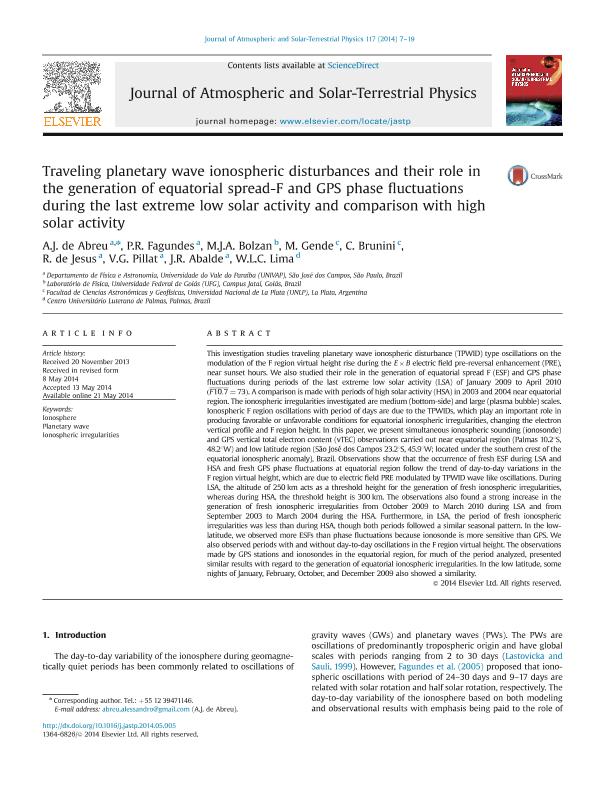Artículo
Traveling planetary wave ionospheric disturbances and their role in the generation of equatorial spread-F and GPS phase fluctuations during the last extreme low solar activity and comparison with high solar activity
de Abreu, A. J.; Fagundes, P. R.; Bolzan, M. J. A.; Gende, Mauricio Alfredo ; Brunini, Claudio Antonio
; Brunini, Claudio Antonio ; de Jesus, R.; Pillat, V. G.; Abalde, J. R.; Lima, W. L. C.
; de Jesus, R.; Pillat, V. G.; Abalde, J. R.; Lima, W. L. C.
 ; Brunini, Claudio Antonio
; Brunini, Claudio Antonio ; de Jesus, R.; Pillat, V. G.; Abalde, J. R.; Lima, W. L. C.
; de Jesus, R.; Pillat, V. G.; Abalde, J. R.; Lima, W. L. C.
Fecha de publicación:
05/2014
Editorial:
Elsevier
Revista:
Journal Of Atmospheric And Solar-terrestrial Physics
ISSN:
1364-6826
Idioma:
Inglés
Tipo de recurso:
Artículo publicado
Clasificación temática:
Resumen
This investigation studies traveling planetary wave ionospheric disturbance (TPWID) type oscillations on the modulation of the F region virtual height rise during the EB electric field pre-reversal enhancement (PRE), near sunset hours. We also studied their role in the generation of equatorial spread F (ESF) and GPS phase fluctuations during periods of the last extreme low solar activity (LSA) of January 2009 to April 2010 ðF10:7 ¼73Þ. A comparison ismadewith periods of high solar activity (HSA) in 2003 and 2004 near equatorial region. The ionospheric irregularities investigated are medium (bottom-side) and large (plasma bubble) scales. Ionospheric F region oscillations with period of days are due to the TPWIDs, which play an important role in producing favorable or unfavorable conditions for equatorial ionospheric irregularities, changing the electron vertical profile and F region height. In this paper, we present simultaneous ionospheric sounding (ionosonde) and GPS vertical total electron content (vTEC) observations carried out near equatorial region (Palmas 10.21S, 48.21W) and lowlatitude region (São José dos Campos 23.21S, 45.91W; located under the southern crest of the equatorial ionospheric anomaly), Brazil. Observations show that the occurrence of fresh ESF during LSA and HSA and fresh GPS phase fluctuations at equatorial region follow the trend of day-to-day variations in the F region virtual height, which are due to electric field PREmodulated by TPWID wave like oscillations. During LSA, the altitude of 250 km acts as a threshold height for the generation of fresh ionospheric irregularities, whereas during HSA, the threshold height is 300 km. The observations also found a strong increase in the generation of fresh ionospheric irregularities from October 2009 to March 2010 during LSA and from September 2003 to March 2004 during the HSA. Furthermore, in LSA, the period of fresh ionospheric irregularities was less than during HSA, though both periods followed a similar seasonal pattern. In the low- latitude, we observed more ESFs than phase fluctuations because ionosonde is more sensitive than GPS. We also observed periodswith and without day-to-day oscillations in the F region virtual height. The observations made by GPS stations and ionosondes in the equatorial region, for much of the period analyzed, presented similar results with regard to the generation of equatorial ionospheric irregularities. In the low latitude, some nights of January, February, October, and December 2009 also showed a similarity.
Palabras clave:
Ionosphere
,
Planetary Wave
,
Ionospheric Irregularities
Archivos asociados
Licencia
Identificadores
Colecciones
Articulos(IAFE)
Articulos de INST.DE ASTRONOMIA Y FISICA DEL ESPACIO(I)
Articulos de INST.DE ASTRONOMIA Y FISICA DEL ESPACIO(I)
Citación
de Abreu, A. J.; Fagundes, P. R.; Bolzan, M. J. A.; Gende, Mauricio Alfredo; Brunini, Claudio Antonio; et al.; Traveling planetary wave ionospheric disturbances and their role in the generation of equatorial spread-F and GPS phase fluctuations during the last extreme low solar activity and comparison with high solar activity; Elsevier; Journal Of Atmospheric And Solar-terrestrial Physics; 117; 1; 5-2014; 7-19
Compartir
Altmétricas



